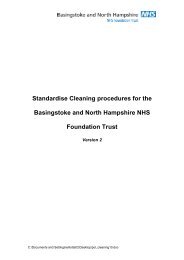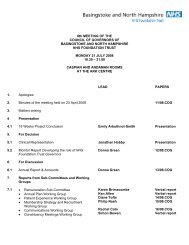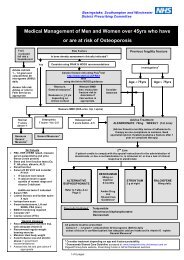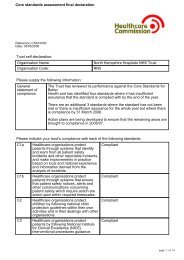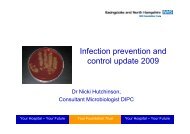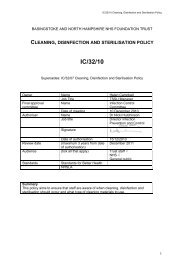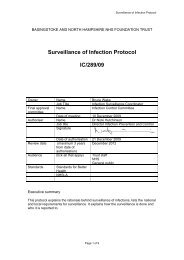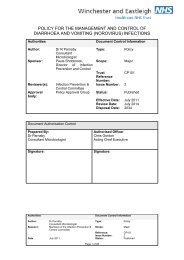Isolation and infectious diseases policy - Hampshire Hospitals NHS ...
Isolation and infectious diseases policy - Hampshire Hospitals NHS ...
Isolation and infectious diseases policy - Hampshire Hospitals NHS ...
You also want an ePaper? Increase the reach of your titles
YUMPU automatically turns print PDFs into web optimized ePapers that Google loves.
Winchester & Eastleigh Healthcare <strong>NHS</strong> Trust<br />
Policy for <strong>Isolation</strong> <strong>and</strong> Infectious Diseases Policy<br />
5.3 Modes of transmission<br />
The emergence of Severe Acute Respiratory Syndrome (SARS) in 2002, the<br />
importation of monkeypox into the United States in 2003, <strong>and</strong> the emergence of<br />
avian influenza present challenges to the assignment of isolation categories<br />
because of conflicting information <strong>and</strong> uncertainty about possible routes of<br />
transmission. Although SARS-CoV is transmitted primarily by contact <strong>and</strong>/or<br />
droplet routes, airborne transmission over a limited distance (e.g. within a room),<br />
has been suggested, though not proven.<br />
5.3.1 Certain <strong>diseases</strong> may be transmitted between patients <strong>and</strong> potentially<br />
between patients <strong>and</strong> members of staff e.g. Methicillin Resistant<br />
Staphylococcus aureus (MRSA). Therefore it is sometimes necessary to<br />
isolate patients who are infected or those who are particularly vulnerable to<br />
infection.<br />
5.3.2 The aim of isolation is to control, confine <strong>and</strong> minimize the spread of microorganisms.<br />
As underst<strong>and</strong>ing of transmission of infection has improved,<br />
isolation practices have become more evidence based <strong>and</strong> targeted (Damaini<br />
2003)<br />
5.3.3 Infection can be spread by a number of methods: airborne, droplet, contact<br />
<strong>and</strong> blood borne spread.<br />
5.3.4 Airborne transmission occurs by dissemination of droplet nuclei or dust<br />
particles containing the <strong>infectious</strong> agent; microorganisms are therefore<br />
dispersed widely over long distances.<br />
5.3.5 Droplet transmission. Droplets (1-10um in diameter) are generated from the<br />
source person primarily during coughing with influenza, sneezing <strong>and</strong> talking<br />
<strong>and</strong> are propelled a short distance only; hence special ventilation is not<br />
required to prevent transmission.<br />
5.3.6 Direct contact transmission is the most important <strong>and</strong> frequent mode of<br />
transmission contact transmission <strong>and</strong> involves either direct person-to-person<br />
contact or indirect contact via a contaminated intermediate object (sometimes<br />
called a fomite). Direct is by skin to skin contact <strong>and</strong> therefore the physical<br />
transfer of microbes from an infected or colonized patient to a susceptible<br />
host.<br />
5.3.7 Indirect contact transmission occurs when a susceptible patient comes into<br />
contact with a contaminated object e.g. equipment such as a commode.<br />
8<br />
Authorities<br />
Document Control Information<br />
Author:<br />
Sponsor:<br />
Date:<br />
Dr Kordo Saeed<br />
microbiologist<br />
Sue Dailly Lead Nurse<br />
Infection Prevention <strong>and</strong><br />
Control<br />
Paula Shobbrook Director of<br />
Infection Prevention <strong>and</strong><br />
Control<br />
01/08/11<br />
Type:<br />
Scope:<br />
Reference:<br />
Issue No:<br />
Status:<br />
Policy<br />
Major<br />
CP022 (IC 04)<br />
4<br />
Published



